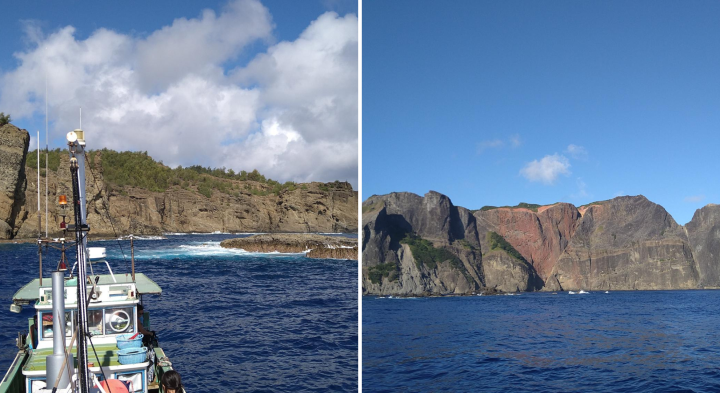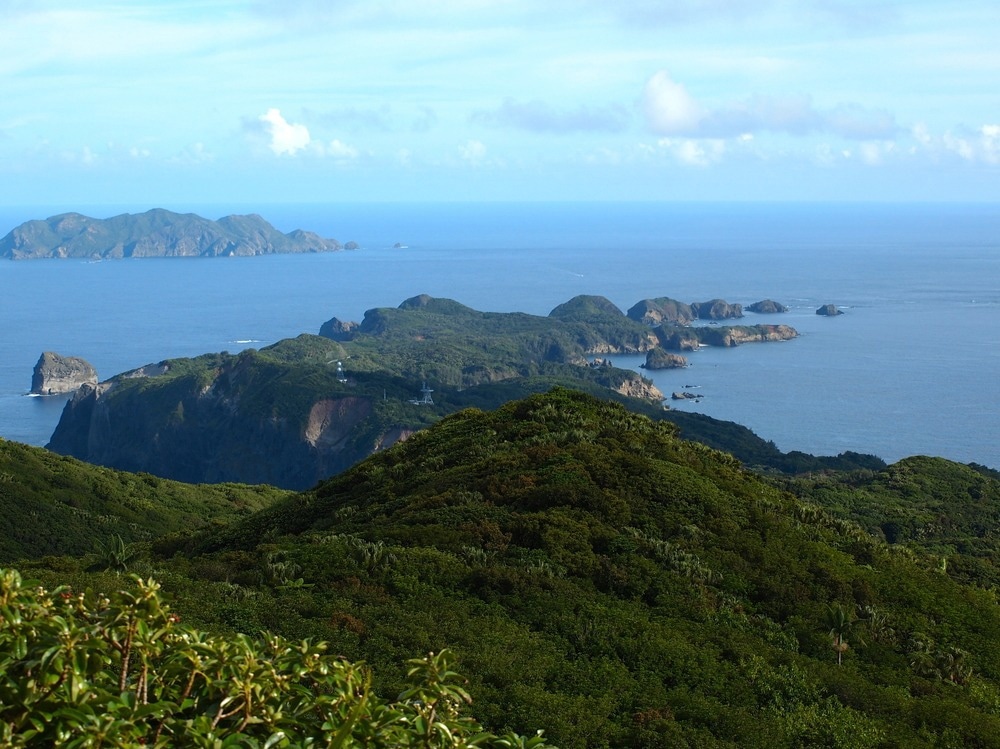The Ogasawara Islands are a chain of tiny volcanic islands located thousands of km South of Tokyo, deep within the world's largest ocean. Here, isolated from human habitation and the warm Kuroshio current that shuttles marine species from Taiwan over the Ryukyu Islands and up the Pacific coast of mainland Japan, nature has been allowed to flourish on its own terms.
 The research vessel, used to collect samples of seawater for the study. Right: Underwater scenery at the Ogasawara Islands. Image Credit: James D. Reimer.
The research vessel, used to collect samples of seawater for the study. Right: Underwater scenery at the Ogasawara Islands. Image Credit: James D. Reimer.
The islands, which are home to many endemic animal species and up to 70% of trees, have earned the moniker “the Galápagos of the East” for their significance as a hotspot for biodiversity and as the birthplace of scientific inquiry. They were recognized in 2011 as a UNESCO Natural World Heritage site.
Although there has not been much direct human involvement with the environment here, climate change poses a global threat to biodiversity. Geographic remoteness is a boon and a bane, as it makes it challenging to periodically evaluate the ecological well-being of these special islands.
But advances in environmental DNA (eDNA) sequencing could enable monitoring the state of nature here and in other far-flung places safer, less expensive, and less susceptible to human mistake.
A group of researchers from the Okinawa Institute of Science and Technology (OIST) made a visit to the islands in 2021. Ayşe Haruka Oshima Açıkbaş, a Ph.D. Student, Professor Timothy Ravasi from OIST's Marine Climate Change Unit, and Professor James Reimer from the University of the Ryukyus were on board the vessel. The three embarked on an expedition to gather seawater buckets at certain locations throughout the archipelago for the OIST lab, with the goal of counting the fish and coral that might be living there.

Image Credit: Tsuyoshi_Kaneko/Shutterstock.com
The results of their analysis, which they conducted in conjunction with colleagues from OIST's Marine Genomics Unit, have been released in the journal Environmental DNA.
From samples taken from the waters surrounding two of 31 Ogasawara islands, the researchers found 38 distinct genera of coral and 124 unique species of fish. They were shocked to see species that had never been documented before or were assumed to have a range in the area, such as fish that were thought to be endemic to Hawaii and coral species that were not expected to be found there.
Because it is so simple to harvest and maintain, the coral (Catalaphyllia jardinei), is one of those in danger of being overfished by aquarium hobbyists.
Oshima Açıkbaş said, “The islands are likely an important source of fish and coral larvae, like the Catalaphyllia, for the biodiversity in the wider area of the Pacific Ocean.”
The study also illustrates how biodiversity is impacted by human development. The group took saltwater samples from three locations along Futami Bay on Chichi Island, which is home to the port for the main settlement. These locations were quite close to one another.
On the western and eastern sides of the bay, we found a high richness of coral genera. But within the small port we found very low richness – so even very locally like this, we see the effect on coral biodiversity that human development has.”
Ayşe Haruka Oshima Açıkbaş, Study First Author and Ph.D. Student, Okinawa Institute of Science and Technology
The Ogasawara Islands may seem like a safe haven for biodiversity due to their remote location and low degree of development, but they are ultimately not immune to local and global dangers. Over time, there have been accounts of coral bleaching and the devastation of nearby coral reefs due to port construction.
Professor Ravasi said, “It is a cause of concern, and points to the importance of bio-monitoring efforts with techniques like eDNA sampling.”
Similar to the Galápagos Islands, this area's high endemism is a source of both inspiration and concern for scientists.
If you lose an endemic species here, they go extinct and you lose a very important component of the ecosystem that makes it that ecosystem.”
Ayşe Haruka Oshima Açıkbaş, Study First Author and PhD Student, Okinawa Institute of Science and Technology
Compared to more conventional approaches that require skilled divers or video drones, sampling seawater for eDNA analysis can provide an effective way to monitor biodiversity in isolated areas like the Ogasawara Islands.
This approach can incorporate government employees such as park rangers and citizen scientists in addition to routine data gathering, making ecosystem health monitoring easier and more thorough.
The technology has improved over time, making the cost of sequencing cheaper, which leads to a greater adoption, in turn leading to increased innovation and decreased costs. It is a positive spiral.”
Timothy Ravasi, Professor, Okinawa Institute of Science and Technology
Ayşe Haruka Oshima Açıkbaş said, “Although our sampling was a one-off occurrence, the findings from the research can be used for future references. More broadly, sampling water for eDNA analysis can readily be integrated into continuous biomonitoring efforts.”
Source:
Journal reference:
Açıkbaş, A. H., et al. (2024) Fish and coral assemblages of a highly isolated oceanic island: The first eDNA survey of the Ogasawara Islands. Environmental DNA. doi.org/10.1002/edn3.509.